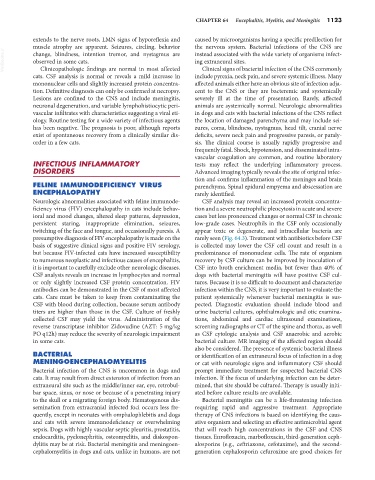Page 1151 - Small Animal Internal Medicine, 6th Edition
P. 1151
CHAPTER 64 Encephalitis, Myelitis, and Meningitis 1123
extends to the nerve roots, LMN signs of hyporeflexia and caused by microorganisms having a specific predilection for
muscle atrophy are apparent. Seizures, circling, behavior the nervous system. Bacterial infections of the CNS are
VetBooks.ir change, blindness, intention tremor, and nystagmus are instead associated with the wide variety of organisms infect-
ing extraneural sites.
observed in some cats.
Clinical signs of bacterial infection of the CNS commonly
Clinicopathologic findings are normal in most affected
cats. CSF analysis is normal or reveals a mild increase in include pyrexia, neck pain, and severe systemic illness. Many
mononuclear cells and slightly increased protein concentra- affected animals either have an obvious site of infection adja-
tion. Definitive diagnosis can only be confirmed at necropsy. cent to the CNS or they are bacteremic and systemically
Lesions are confined to the CNS and include meningitis, severely ill at the time of presentation. Rarely, affected
neuronal degeneration, and variable lymphohistiocytic peri- animals are systemically normal. Neurologic abnormalities
vascular infiltrates with characteristics suggesting a viral eti- in dogs and cats with bacterial infections of the CNS reflect
ology. Routine testing for a wide variety of infectious agents the location of damaged parenchyma and may include sei-
has been negative. The prognosis is poor, although reports zures, coma, blindness, nystagmus, head tilt, cranial nerve
exist of spontaneous recovery from a clinically similar dis- deficits, severe neck pain and progressive paresis, or paraly-
order in a few cats. sis. The clinical course is usually rapidly progressive and
frequently fatal. Shock, hypotension, and disseminated intra-
vascular coagulation are common, and routine laboratory
INFECTIOUS INFLAMMATORY tests may reflect the underlying inflammatory process.
DISORDERS Advanced imaging typically reveals the site of original infec-
tion and confirms inflammation of the meninges and brain
FELINE IMMUNODEFICIENCY VIRUS parenchyma. Spinal epidural empyema and abscessation are
ENCEPHALOPATHY rarely identified.
Neurologic abnormalities associated with feline immunode- CSF analysis may reveal an increased protein concentra-
ficiency virus (FIV) encephalopathy in cats include behav- tion and a severe neutrophilic pleocytosis in acute and severe
ioral and mood changes, altered sleep patterns, depression, cases but less pronounced changes or normal CSF in chronic
persistent staring, inappropriate elimination, seizures, low-grade cases. Neutrophils in the CSF only occasionally
twitching of the face and tongue, and occasionally paresis. A appear toxic or degenerate, and intracellular bacteria are
presumptive diagnosis of FIV encephalopathy is made on the rarely seen (Fig. 64.3). Treatment with antibiotics before CSF
basis of suggestive clinical signs and positive FIV serology, is collected may lower the CSF cell count and result in a
but because FIV-infected cats have increased susceptibility predominance of mononuclear cells. The rate of organism
to numerous neoplastic and infectious causes of encephalitis, recovery by CSF culture can be improved by inoculation of
it is important to carefully exclude other neurologic diseases. CSF into broth enrichment media, but fewer than 40% of
CSF analysis reveals an increase in lymphocytes and normal dogs with bacterial meningitis will have positive CSF cul-
or only slightly increased CSF protein concentration. FIV tures. Because it is so difficult to document and characterize
antibodies can be demonstrated in the CSF of most affected infection within the CNS, it is very important to evaluate the
cats. Care must be taken to keep from contaminating the patient systemically whenever bacterial meningitis is sus-
CSF with blood during collection, because serum antibody pected. Diagnostic evaluation should include blood and
titers are higher than those in the CSF. Culture of freshly urine bacterial cultures, ophthalmologic and otic examina-
collected CSF may yield the virus. Administration of the tions, abdominal and cardiac ultrasound examinations,
reverse transcriptase inhibitor Zidovudine (AZT: 5 mg/kg screening radiographs or CT of the spine and thorax, as well
PO q12h) may reduce the severity of neurologic impairment as CSF cytologic analysis and CSF anaerobic and aerobic
in some cats. bacterial culture. MR imaging of the affected region should
also be considered. The presence of systemic bacterial illness
BACTERIAL or identification of an extraneural focus of infection in a dog
MENINGOENCEPHALOMYELITIS or cat with neurologic signs and inflammatory CSF should
Bacterial infection of the CNS is uncommon in dogs and prompt immediate treatment for suspected bacterial CNS
cats. It may result from direct extension of infection from an infection. If the focus of underlying infection can be deter-
extraneural site such as the middle/inner ear, eye, retrobul- mined, that site should be cultured. Therapy is usually initi-
bar space, sinus, or nose or because of a penetrating injury ated before culture results are available.
to the skull or a migrating foreign body. Hematogenous dis- Bacterial meningitis can be a life-threatening infection
semination from extracranial infected foci occurs less fre- requiring rapid and aggressive treatment. Appropriate
quently, except in neonates with omphalophlebitis and dogs therapy of CNS infections is based on identifying the caus-
and cats with severe immunodeficiency or overwhelming ative organism and selecting an effective antimicrobial agent
sepsis. Dogs with highly vascular septic pleuritis, prostatitis, that will reach high concentrations in the CSF and CNS
endocarditis, pyelonephritis, osteomyelitis, and diskospon- tissues. Enrofloxacin, marbofloxacin, third-generation ceph-
dylitis may be at risk. Bacterial meningitis and meningoen- alosporins (e.g., ceftriaxone, cefotaxime), and the second-
cephalomyelitis in dogs and cats, unlike in humans, are not generation cephalosporin cefuroxime are good choices for

